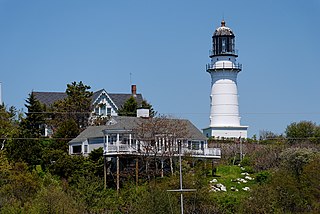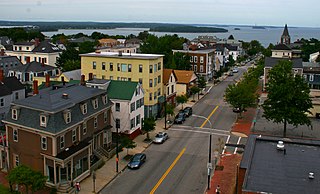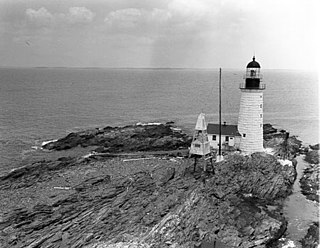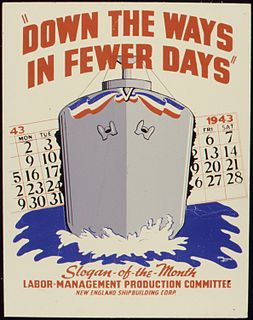 W
WCasco Bay is an inlet of the Gulf of Maine on the southern coast of Maine, New England, United States. Its easternmost approach is Cape Small and its westernmost approach is Two Lights in Cape Elizabeth. The city of Portland sits along its southern edge and the Port of Portland lies within.
 W
WBattery Steele is a United States military fortification on Peaks Island, Portland, Maine in Casco Bay. Completed in 1942 as part of World War II, it is located on 14 acres (5.7 ha) on the oceanside area of the island, formerly part of the Peaks Island Military Reservation. It is named for Harry Lee Steele, who was a Coast Artillery officer during World War I. It was armed with two 16-inch MkIIMI guns and, with a 12-inch gun battery at Fort Levett on Cushing Island, replaced all previous heavy guns in the Harbor Defenses of Portland. It was built to protect Casco Bay, particularly Portland harbor, from Kennebunk to Popham Beach in Phippsburg. According to Kim MacIsaac and historian Joel Eastman in An Island at War, “Battery Steele is not only the largest gun battery built on Peaks Island, but also an example of the largest battery ever built anywhere in the United States.” In 1995, after decades of non-use, the Peaks Island Land Preserve, a community land preservation group, formed to purchase the area and forever preserve it as a public space. On October 20, 2005, the property was listed on the National Register of Historic Places. Other coast defense structures on the island include fire control towers and the counterweight for a disappearing searchlight tower.
 W
WThe Battle of Falmouth involved Joseph-François Hertel de la Fresnière and Baron de St Castin leading troops as well as the Wabanaki Confederacy in New Brunswick to capture and destroy Fort Loyal and the English settlement on the Falmouth neck, then part of the Massachusetts Bay Colony. The commander of the fort was Captain Sylvanus Davis. After two days of siege, the settlement's fort, called Fort Loyal, surrendered. The community's buildings were burned, including the wooden stockade fort, and its people were either killed or taken prisoner. The fall of Fort Loyal (Casco) led to the near depopulation of Europeans in Maine. Native forces were then able to attack the New Hampshire frontier without reprisal.
 W
WCape Elizabeth Light is a lighthouse in Cape Elizabeth, at the southwestern entrance to Casco Bay in Maine.
 W
WCape Elizabeth is a town in Cumberland County, Maine, United States. The town is part of the Portland–South Portland–Biddeford, Maine, metropolitan statistical area. As of the 2010 census, Cape Elizabeth had a population of 9,015.
 W
WFalmouth is a town in Cumberland County, Maine, United States. The population was 11,185 at the 2010 census. It is part of the Portland–South Portland–Biddeford, Maine metropolitan statistical area.
 W
WMunjoy Hill is a neighborhood and prominent geographical feature of Portland, Maine. It is located east of downtown and south of East Deering, the neighborhood it is connected to by Tukey's Bridge. The neighborhood historically had a large Irish and Italian American population.
 W
WFort Gorges is a former United States military fort built on Hog Island Ledge in Casco Bay, Maine. Built from 1858 to 1864, no battles were fought there and no troops were stationed there. Advancing military technology, including iron clad ships and long range guns, made the fort obsolete before it could be used. The fort is now a park, accessible only by boat. It was added to the National Register of Historic Places in 1973.
 W
WFort Levett was a former U.S. Army fort built on Cushing Island, Maine beginning in 1898. Located in Cumberland County, Maine, in Casco Bay near Portland, Maine, the fort was heavily fortified with guns for coastal defense. Conceived under the Endicott Program in 1885 and begun in the wake of the Spanish–American War, Fort Levett was manned during both World Wars. It was part of the Coast Defenses of Portland, later renamed the Harbor Defenses of Portland, a command which protected Portland's port and naval anchorage 1904-1950. The fort's name is sometimes mis-spelled as "Fort Leavitt".
 W
WFort McKinley is a former United States Army coastal defense fort on Great Diamond Island, Maine in Casco Bay, which operated from 1873 to 1947. It was named for President William McKinley. It included a sub-post, Fort Lyon, on Cow Island, just north of Great Diamond Island. Fort Lyon was named for Nathaniel Lyon. Both forts were part of the Coast Defenses of Portland, renamed the Harbor Defenses of Portland in 1925, a command which protected Portland's port and naval anchorage 1895-1950. In 1946 Fort Lyon was closed and turned over to the City of Portland. After Fort McKinley's closure it was transferred to the United States Navy, which sold the site to private interests in 1961. The Fort McKinley Historic District was listed on the National Register of Historic Places in 1985.
 W
WFort Preble was a military fort in South Portland, Maine, United States, built in 1808 and progressively added to through 1906. It is now on the campus of Southern Maine Community College.
 W
WHouse Island is a private island in Portland Harbor in Casco Bay, Maine, United States. It is part of the City of Portland. The island is accessible only by boat. Public access is prohibited, except for an on-request tour sanctioned by the island's owners. House Island includes three buildings on the east side and Fort Scammell on the west side. The buildings are used as summer residences. The island's name derives from the site of an early European house, believed that built by Capt. Christopher Levett, an English explorer of the region.
 W
WFort Sumner was a coastal defense fortification on Munjoy Hill in Portland, Maine, United States. It was built in 1794 as part of the first system of coastal fortifications built by the United States. It was reportedly originally named Fort Allen after the nearby Revolutionary War battery that probably became part of Fort Sumner, but was renamed in 1797 after Increase Sumner, the incumbent Governor of Massachusetts, of which Maine was then a part. The location is now Fort Sumner Park, also called Standpipe Park, at 60 North Street.
 W
WFort Williams is a former United States Army fort in Cape Elizabeth, Maine which operated from 1872 to 1964. It was part of the Coast Defenses of Portland, later renamed the Harbor Defenses of Portland, a command which protected Portland's port and naval anchorage 1904-1950. After its closure, it was redeveloped into Fort Williams Park.
 W
WFreeport is a town in Cumberland County, Maine, United States. The population was 7,879 at the 2010 census. Known for its numerous outlet stores, Freeport is home to L.L. Bean, Wolfe's Neck Woods State Park, and the Desert of Maine.
 W
WHalfway Rock Lighthouse is a lighthouse located on a barren ledge in Casco Bay, Maine. The lighthouse tower, which has a height of 76 feet (23 m), and the attached ex-boathouse are all that remain, as the other buildings have been taken away in storms. The name "Halfway Rock" comes from the position of the rock which is halfway between Cape Elizabeth and Cape Small, the southwest and northeast extremities of Casco Bay, which are about 18 nautical miles (33 km) apart.
 W
WThe Harbor Defenses of Portland was a United States Army Coast Artillery Corps harbor defense command. It coordinated the coast defenses of Portland, Maine, the mouth of the Kennebec River, and surrounding areas from 1895 to 1950, beginning with the Endicott program. These included both coast artillery forts and underwater minefields. The command originated circa 1895 as the Portland Artillery District, was renamed Coast Defenses of Portland in 1913, and again renamed Harbor Defenses of Portland in 1925.
 W
WHarpswell is a town in Cumberland County, Maine, United States, within Casco Bay in the Gulf of Maine. The population was 4,740 at the 2010 census. Harpswell is composed of land contiguous with the rest of Cumberland County, called Harpswell Neck, as well as three large islands connected by bridges: Sebascodegan Island, Orr's Island, and Bailey Island and over 200 smaller islands. Harpswell is part of the Portland–South Portland–Biddeford, Maine Metropolitan Statistical Area.
 W
WCapt. Christopher Levett was an English writer, explorer and naval captain, born at York, England. He explored the coast of New England and secured a grant from the King to settle present-day Portland, Maine, the first European to do so. Levett left behind a group of settlers at his Maine plantation in Casco Bay, but they were never heard from again. Their fate is unknown. As a member of the Plymouth Council for New England, Levett was named the Governor of Plymouth in 1623 and a close adviser to Capt. Robert Gorges in his attempt to found an early English colony at Weymouth, Massachusetts, which also failed. Levett was also named an early governor of Virginia in 1628, according to Parliamentary records at Whitehall.
 W
WThe Little Mark Island Monument is a historic day beacon and shipwreck refuge on Little Mark Island in northern Casco Bay off the southern coast of the United States state of Maine. The monument, a pyramidal stone structure built in 1827, is one of only three such structures ever built in the state, and is now topped by a beacon light. It is owned and managed by the United States Coast Guard, and is an active aid to navigation. It was listed on the National Register of Historic Places in 2016.
 W
WThe Harbor Defenses of Portland was a United States Army Coast Artillery Corps harbor defense command. It coordinated the coast defenses of Portland, Maine, the mouth of the Kennebec River, and surrounding areas from 1895 to 1950, beginning with the Endicott program. These included both coast artillery forts and underwater minefields. The command originated circa 1895 as the Portland Artillery District, was renamed Coast Defenses of Portland in 1913, and again renamed Harbor Defenses of Portland in 1925.
 W
WThe New England Shipbuilding Corporation was a shipyard located in the city of South Portland, Maine, United States. The yard originated as two separate entities, the Todd-Bath Iron Shipbuilding Corporation and the South Portland Shipbuilding Corporation, which were created in 1940 and 1941 respectively, in order to meet the demand created by World War II. The two merged in 1943, then continued to produce ships as the New England Shipbuilding Corporation's East Yard and West Yard. New England Shipbuilding ranked 97th among United States corporations in the value of World War II military production contracts. Both closed at the end of the war.
 W
WThe Port of Portland is the largest tonnage seaport in New England as well as a major seaport along the east coast of the United States. It is also the second largest oil port on the East Coast, processing 149,616,287 barrels (23,787,088.7 m3) of oil in 2007, mostly through the Portland–Montreal Pipe Line, and the largest foreign inbound transit tonnage port in the United States.
 W
WPortland is the most populous city in the U.S. state of Maine and the seat of Cumberland County. Portland's population was 66,215 as of 2019. The Greater Portland metropolitan area is home to over half a million people, the 105th-largest metropolitan area in the United States. Portland's economy relies mostly on the service sector and tourism. The Old Port district is known for its 19th-century architecture and nightlife. Marine industry still plays an important role in the city's economy, with an active waterfront that supports fishing and commercial shipping. The Port of Portland is the largest tonnage seaport in New England.
 W
WThe New England Shipbuilding Corporation was a shipyard located in the city of South Portland, Maine, United States. The yard originated as two separate entities, the Todd-Bath Iron Shipbuilding Corporation and the South Portland Shipbuilding Corporation, which were created in 1940 and 1941 respectively, in order to meet the demand created by World War II. The two merged in 1943, then continued to produce ships as the New England Shipbuilding Corporation's East Yard and West Yard. New England Shipbuilding ranked 97th among United States corporations in the value of World War II military production contracts. Both closed at the end of the war.
 W
WSouth Portland is a city in Cumberland County, Maine, United States, and is the fourth-largest city in the state, incorporated in 1898. As of the 2010 census, the city population was 25,002. Known for its working waterfront, South Portland is situated on Portland Harbor and overlooks the skyline of Portland and the islands of Casco Bay. Due to South Portland's close proximity to air, marine, rail, and highway transportation options, the city has become a center for retail and industry in the region.
 W
WThe New England Shipbuilding Corporation was a shipyard located in the city of South Portland, Maine, United States. The yard originated as two separate entities, the Todd-Bath Iron Shipbuilding Corporation and the South Portland Shipbuilding Corporation, which were created in 1940 and 1941 respectively, in order to meet the demand created by World War II. The two merged in 1943, then continued to produce ships as the New England Shipbuilding Corporation's East Yard and West Yard. New England Shipbuilding ranked 97th among United States corporations in the value of World War II military production contracts. Both closed at the end of the war.
 W
WYarmouth is a town in Cumberland County, Maine, located twelve miles north of the state's largest city, Portland. The town was settled, while a district of Massachusetts, in 1636 and incorporated in 1849, 29 years after its admittance to the Union. Its population was 8,349 in the 2010 census. As of 2018's estimation of 8,518, this is about 0.6% of Maine's total population. Five islands are part of the town.